Combat "Owl" Luftwaffe
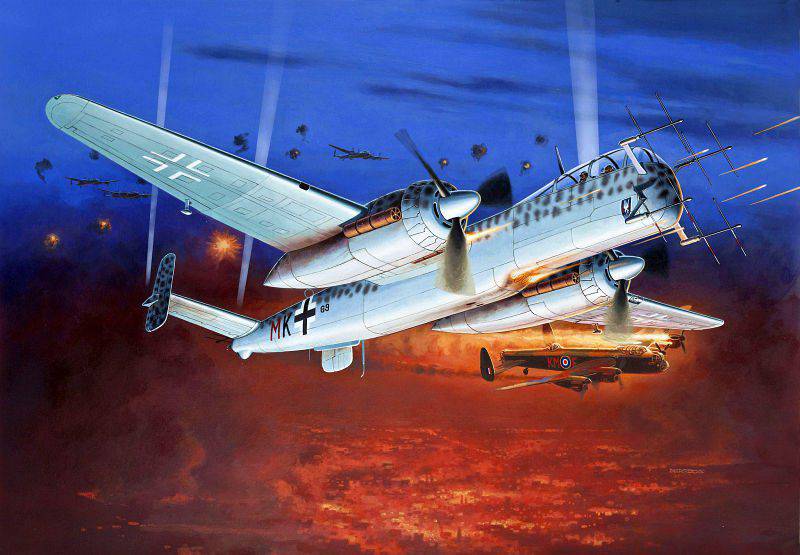
With the start of the bombing of German cities in the summer of 1940, a sensitive blow was struck against the complacency that prevailed among the high command of the Luftwaffe, where only a few, including the future general "from night fighters" Joseph Kammhuber, considered it necessary to have specialized night fighters in the air defense system. The Germans were forced to improvise, adapting existing machines for this purpose. With the increasing activity of the British night bombers, the inadequacy of their opposition to the Bf.110 fighters became more and more apparent. An urgent need has been to provide groups of nightlights with more efficient and suitable aircraft for this purpose. In addition to the increased production of fighters based on Ju 88 bombers in the summer of 1942, the Technical Department sent some wishes to the Focke-Wulf and Heinkel firms. According to them, “Focke-Wulf” was to immediately begin to develop a new specialized night fighter, and “Heinkel” - to adapt a project for this purpose, which was launched two years earlier.
The development of the new machine, the Ta-154, was never brought to the adoption of the aircraft. But the Heinkel fighter He 219, originally created as a multi-purpose machine, eventually became a highly specialized night fighter, and as such has achieved remarkable success. Not 219 turned out to be one of the most effective aircraft of the Second World War. And in the case of mass use (as envisaged in the original plans), he, according to experts, could lead to a change in the situation in night battles in the sky of the Third Reich. But first things first.
Small german aviation Ernst Heinkel’s company, established in 1922, by the beginning of World War II turned into a huge concern uniting several factories. Of all German firms, it was Heinkel that was considered the most advanced in the creation of high-speed aircraft, distinguished by perfect aerodynamic forms. A clear evidence of this was He 70 and He 100.
Since 1936, the company has been doing a lot of work to create a twin-engine high-speed reconnaissance bomber He 119, which had an unusual layout. Its two engines were not placed on the wing, but in the fuselage behind the crew cabin, and the propeller was rotated by means of a long shaft.
In spite of good flight data, the difficulties of bringing the twin engine installation placed inside the fuselage did not allow the Germans to launch the aircraft into mass production. Nevertheless, Heinkel, on his own initiative, continued research in this direction. The project of the new improved intelligence officer, the work on which began in August of 1940, was in many ways reminiscent of Non-119. He also had two twin engines installed behind the cockpit. True, the propellers had to be coaxial, and the tail - two-tail. By analogy with He 119, the aircraft received the designation He 219, to which was then added the name "Uhu" ("Owl").
In July, the second version of 1941 appeared, on which the twinned DВ613 engine was located already in front of the cabin in the forward fuselage. This placement of the power plant did not require an extended shaft. This somewhat worsened the aerodynamics, as it was necessary to perform the cockpit protruding beyond the fuselage, to provide the necessary overview. But even in this case, the frontal resistance was significantly lower than that of similar twin-engine aircraft with the placement of engines on the wing.
But he failed to realize the intended. At this time, the English night bombers more and more began to strike at the "millennial Reich." To repel these air raids in Germany, anti-aircraft interceptors were used based on heavy Bf.110 fighters and Ju 88 and Dо217 bombers. However, the speed of these aircraft was insufficient. And then they remembered about the Heinkel company and its high-speed cars.
At the beginning of 1941, Heinkel received a task to build a night fighter, and in April of the following year, the drawings of the new aircraft were completed and their implementation into metal began. From the original layout had to be abandoned. Coaxial screws installed in the nose of the fuselage, prevented the placement of the radar station, whose experimental version of which was created by the Germans in the summer of the 1941 of the year and gunfire weapons. Therefore, the aircraft, to the detriment of aerodynamics, had to be done according to the classical scheme with two DВ603А engines with 1700 hp power installed on the wing.
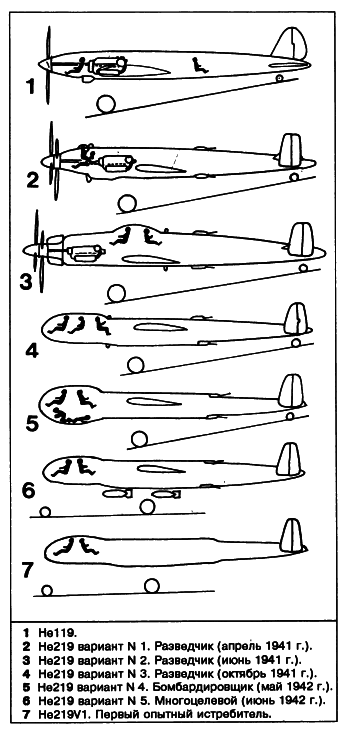
Due to the fact that when attacking enemy bombers, the fighter was subjected to heavy shelling, it had to have a very powerful reservation. From the front hemisphere, the crew of the Non 219 was reliably protected by armor plates with a thickness of 15-20 mm and armored glass. Moreover, in front of the bulletproof glass there was another mobile armored shutter with a small cut for the sight, which at the time of the attack additionally covered the pilot from enemy fire. The armor plates installed in the engine pods covered the maslobak. The reservation of the crew and systems from the rear hemisphere was absent, since it was believed that the night interceptor would not be bombarded from this direction.
The aircraft’s armament was also very powerful. It included six MG 151 / 20 guns of the 20 caliber mm (two guns stood in the root of the wing and four in the removable fairing under the fuselage). Instead of 20-mm guns, 30-mm Mk 103 or Mk 108 could be installed. For this, the walls of the cartridge boxes could be rearranged for any cartridge. According to such a criterion as the weight of a minute salvo, the 219 He was not considered one of the most powerful fighters of the Second World War period.
The night interceptor fighter did not need defensive armament; therefore, two remotely controlled machine gun turrets located on the He 219, which was originally developed also in reconnaissance and bomber versions with defensive armament, were dismantled. Because of this, on the fuselage of an experienced fighter He 219V1 preserved characteristic protrusions, which were subsequently eliminated on production machines.
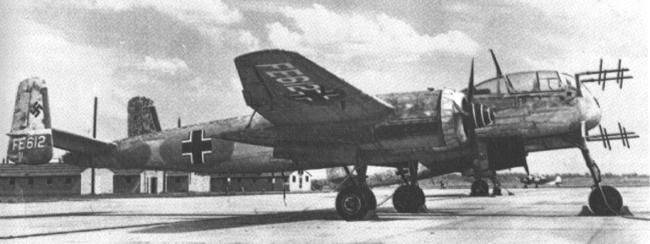
It is worth noting that in the design many new technical solutions were used, such as ejection seats of the pilot and radar operator. Chassis with nose wheel, flaps with a profiled slot, automatically closed with special flaps, hanging ailerons, adjustable stabilizer in flight, associated with flaps, and much more. To ensure all-weather conditions and eliminate icing, the toes of the wing and the stabilizer were warmed by warm air. The air was heated by special gasoline heaters installed in consoles and a stabilizer.
First flight Not 219V1 was made on November 15 1942 of the year. Tests revealed a number of shortcomings: poor road stability, tail vibration, defects in the mechanism for cleaning the front landing gear. In this regard, the aircraft V1 was used mainly for testing the chassis in terms of its behavior during landing. Due to numerous changes in the design of the wing, this specimen was not subjected to high overloads in flight.
More serious tests passed the improved Non 219V2. Despite the fact that in the end the car crashed, it fulfilled its role. In particular, during the comparative tests with the Ju-188S interceptor, conducted in January 1943 of the year, He 219V2 was the winner (piloted by the plane already mentioned Streib), and was adopted by the air defense aircraft. However, the mass production of the aircraft began only in June. Before this company had to eliminate a number of shortcomings. Ten more experimental machines were built.
The first series of non-XNUMHA-219 fighters was launched at a pilot plant in Vienna, not adapted for mass production. This affected the pace of release. In a month, all 0 machines could be released here. Therefore, the Germans soon had to use for the production of Non-14 and an aircraft factory in Rostock, where it was planned to produce fighter jets on the 219-150 monthly. Fortunately for the Allies, these plans did not come true. Until the end of 200, the German Air Defense received all 1943 vehicles of this type. It was very difficult for the Germans to organize the large-scale production of the new aircraft during the war. In addition, the Allied bomber aircraft did not leave the German aircraft manufacturing plants without their "attention." Otherwise, as the experience of combat use showed, non-26 fighters could cause the British severe trouble.
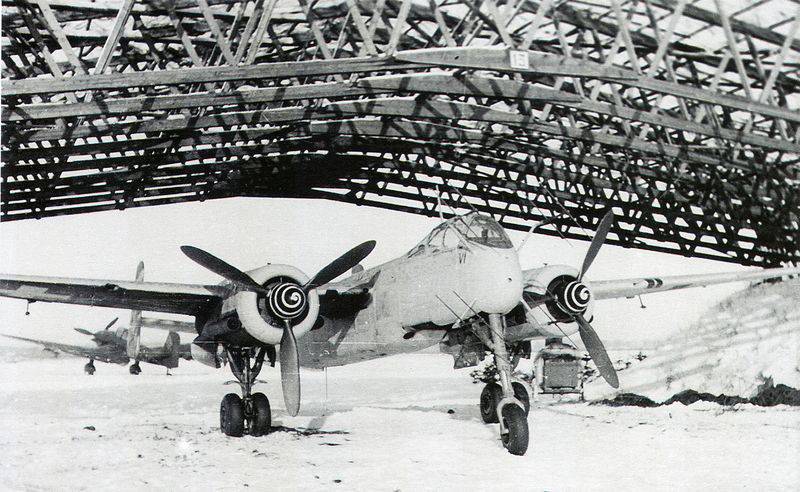
In April, 1943, the first group of night fighter-interceptors, supposedly consisting of four experimental aircraft Not 219, under the command of Streib was sent to Holland on an airfield near Ventlo, to the group 1 / NJG1. It was here on the night of 11 on June 12 that the baptism of new cars took place. Over the next ten nights, the "Owls" shot down British bombers 20, including six Mosquitoes, which were considered practically invulnerable. In the same period, a battle took place in which Streib dealt with five Lancasters. The first success was so great that after two weeks, Streib himself was appointed commander of the entire 1 / NJG1 (this unit was armed mainly with Bf.110 fighter jets), and Captain G. Frank took the place of the subunit of He 219. His career was short. Having shot down a total of 55 aircraft, he 27 September 1943, was killed in a collision with another interceptor. Meyer, who succeeded him, achieved great success, who personally shot down the 1943 Lancaster and Halifax in the second half of 30. But he, too, on the night of 21 on January 1944 of the year, while repelling an Allied air raid on Magdeburg, died crashing into an English bomber on his Heinkel. By this time, 65 air victories were in his combat score.
The loss of the best German pilots testified that the first shock from the appearance of the Non-219 in the enemy had passed. Nightlights increasingly began to fall under the powerful barrage of fire bombers. It is not surprising that all four experienced "Owl", aimed at front-line tests, were destroyed. True, in July, the 1943-219, not the 0-219, but already the upgraded Not 2-2, began to come into service on 219. On A-0 series machines, as well as on some He 30-108, instead of two front vent guns, two 65-mm short-barreled X-guns of the 2, whose barrels were directed upwards at an angle 5 ° to the longitudinal axis of the aircraft, were installed. Such an armament scheme was proposed by gunsmith P. Maglet from 1943 / NJG219 and was intended to bombard bombers from the bottom of the so-called "dead zone". At the same time, the interceptor was supposed to pass under the enemy plane from below and “pierce” it with cannon fire from the tail to the very nose. Tests of such inclined weapons were carried out in August 0. Not 219А-17 was used for these purposes, it was designated Not XNUMXVXNUMX (on this plane the Germans tried to install turbo-compressors and new engine cooling system radiators, and later the same machine took part in front-line tests against the invulnerable Mosquito).
The attempt to introduce general-purpose tactics did not bring success, although many Bf.110 and Dо 217 fighters were similarly refined (the last number of guns mounted at an angle to the horizon reached four). The fact is that the first success was largely due to a complete surprise for the enemy. In addition, it turned out that aiming at a large angle was very inconvenient and made piloting the aircraft more difficult. And the shooting itself at an angle to the oncoming flow caused a strong dispersion of projectiles. As a result, the accuracy of firing of oblique guns was low, and this negated all the advantages of the attack from below.
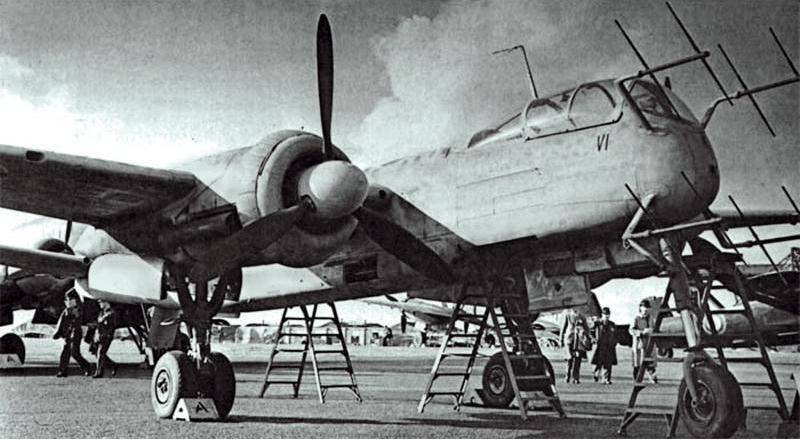
Far from all the "Owls" had similar weapons, but the command of the British Air Force, greatly concerned about the actions of the German interceptors, decided to move to an active fight against them. Possessing high-speed Mosquito fighter-bombers, it laid upon them the function of hunting for the Luftwaffe night-lights. Since December 1943, special "Mosquito", equipped with radar, began to accompany the "Lancaster" and "Halifax" during night raids. Other "Mosquitoes" lurked German fighters in the home areas, or simply blocked their airfields. Under these conditions, the Germans urgently needed an “anti-moskito”. And the only plane that could become one was Not 219.
The new version, designated No 219А-6, was specially facilitated. There was no reservation on it, and there were only four 20-mm guns that fired ahead. But the engine power DВ603L increased to 1980 HP As a result, the maximum flight speed reached 650 km / h and was comparable to the speed of "Mosquito". The "NJGr10" experimental group based in Vermeseni near Berlin specialized on "mosquito" operations.
At the same time, the release of conventional X X NUMX interceptors continued. Thus, the development of aircraft modification A-219 was not 2А-219 with more powerful 5-powerful engines DВ1800Е. At the same time, the A-603 / R5 series aircraft were triple and had an elongated cabin that housed the MG 4 heavy machine gun for defense against enemy fighters from behind.
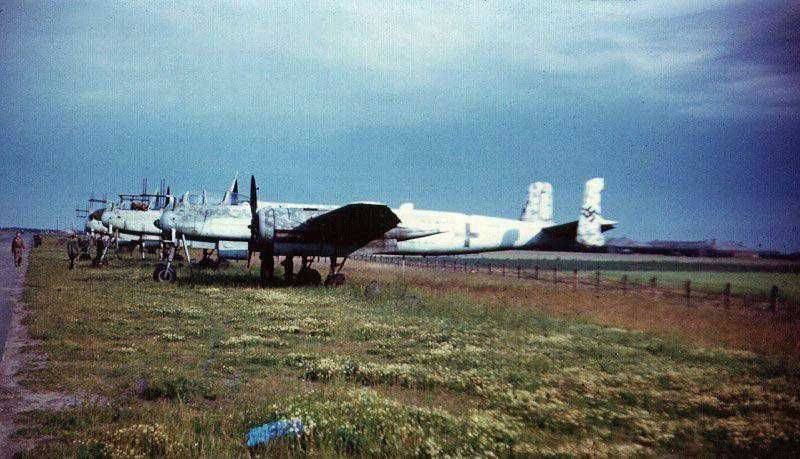
The most common modification was He 219A-7. Its armament consisted, as a rule, of six forward-directed Mk 103, Mk 108 or MG 151 / 20 guns in various combinations and two 108 Mk mounted at an angle to the longitudinal axis of the aircraft. One option (Not 219А-7 / В5) was designed to hunt for "Moskito" and equipped with 1900-strong YuMO 213 engines with a water-methanol boost system. According to various data, its maximum speed ranged from 640 to 670 km / h. Throughout the complex flight performance of the aircraft was quite successful. According to the statements of the flight crew and a number of specialists, He 219 had the best flight performance among all reciprocating twin-engined fighters in Germany.
The deteriorating politico-military situation led the Hitler leadership to take a decision to stop all fighter improvement programs (with the exception of Dо 335) in favor of jet aircraft. However, Heinkel, at his own peril and risk, continued to refine his car, and his factories even in 1945 had time to launch the 62 aircraft, which, however, could no longer extend the agony of the third Reich.
With 1944, the main works were associated with an increase in the ceiling, range and airspeed of He 219. First of all, it concerned the installation on it of the newest YuMO 222 engine 2500 horsepower.
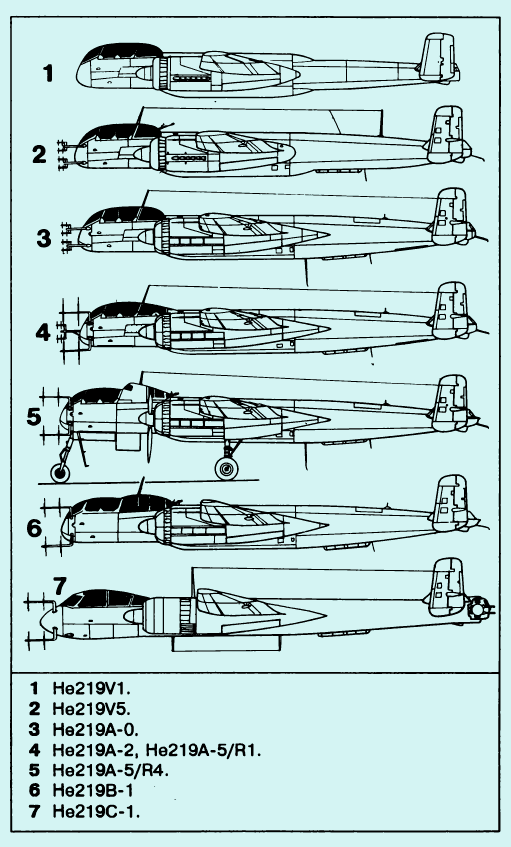
The first such aircraft was an experienced Not 219V16, taken from the A-0 series. In addition to the new engine, a wing with an increased span and a chassis with larger diameter wheels were tested on it. Then followed Non-219V23 and V27. The last of these was the benchmark for the HeN XXUMXВ-219 series of high-altitude interceptors. These aircraft also had to have a larger wing and a greater range due to the placement of fuel tanks in the wing (on He 1A, the fuel tanks were located only in the fuselage). The trophy materials indicate that the He 219В-219 had a two-seater cabin and YuMO 1А / В engines (later-Е / F). Experienced aircraft Not 222V219 and V37, equipped with YuMO 38 engines were taken from the B-222 series. In addition, two more aircraft, Not 1V219 and V39 (both from the А-40 series), as well as V2, were modified according to the B-27 standard. Thus, at least one standard, two experimental and two serial machines of this modification were built.
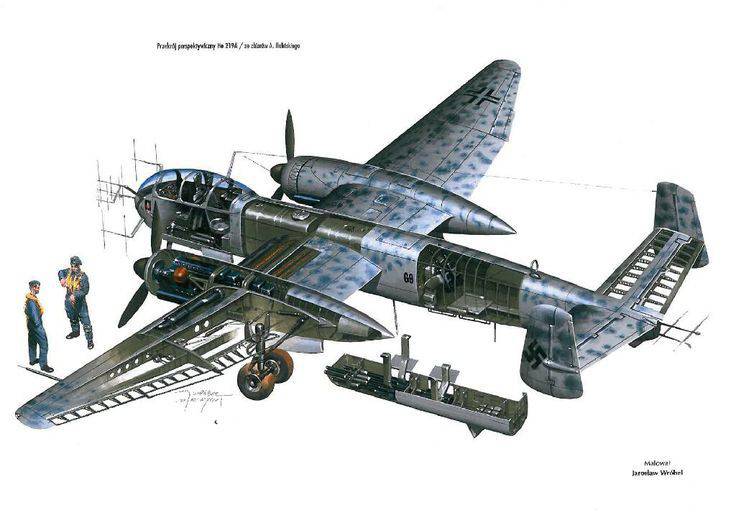
The next modification was Not 219B-2. According to Soviet reports, this car was quite different from the previously created machines. First of all, his three-seater cabin had completely different outlines. But most importantly, the ventral cannon gondola was removed, with the result that the midsection of the fuselage decreased. The armament was placed as follows: two guns of the 108 Mk in the root of the wing, two more - in the nose of the fuselage and two inclined in the fuselage behind the wing. The plane was also installed improved radar equipment. Two such aircraft were built, or rather, they were converted from He 219B-1 (meaning not previously mentioned 219V37 and V38).
The modification of Non-219-1 for captured materials did not differ much from В-2. This "Owl" had the same fuselage (but with a new cabin), the same wing, engines and weapons. The only difference is the heavy tail defensive installation of four large-caliber MG 131 machine guns. To maintain the necessary centering, the engines were carried forward by 30 cm, and the cockpit — a full meter. A series of such planes was laid, but due to the seizure of Heinkel factories by Soviet troops, the work stopped. A further development of the C-1 series was to be a multipurpose Non-219C-2, capable of carrying up to 1500 kg bombs. Powerful offensive (four ZO-mm guns) and defensive weapons, the ability to fly at speeds up to 700 km / h (without flame arresters and radar antennas) would allow using it as a day attack aircraft and high-speed bomber even at the final stage of the war in conditions of superior enemy aviation .
It should be noted that since the end of 1942, in parallel with the development of this fighter, work was also carried out on the design of a special high-altitude aircraft not 419, equipped with turbo-compressors and a pressurized cabin. Moreover, the bomber versions were first worked out, and then, as happened with the He 219, the high-altitude interceptor. It was built six such aircraft. More precisely, they were converted from serial 219 He and differed wing increased area (59 square meters against 44,5 square meters in He 219) and DВ603G engines with turbochargers.
Separate Non-219 was used for various research projects and as flying laboratories. So, on experienced Not 219V24 and VZO jet engines ВМW00З were tested for the fighter Not 162. Electric defrosters and brake parachutes (Not 219V11) were tested. On airplanes He 219V15 and V32 installed chemical weapons and conducted experiments with the spraying of toxic substances. The 219V-33 did not have a parabolic antenna closed by a nose cone.
It is worth noting that the leadership of the Luftwaffe noted the fact that He 219 practically had no problems with the development in combat units, unlike many other machines. It was a really successful and promising aircraft, which allowed him, despite the relatively small number of aircraft built (total 268 machines), to occupy a prominent place in the overall list of the best fighters of the Second World War period. And many of the pilots who flew on it, became famous aces.
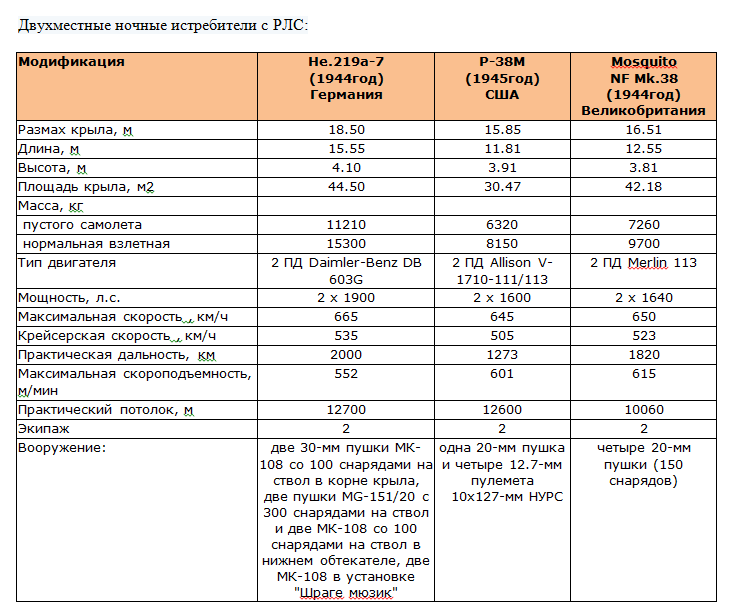
Sources:
Borisov Y. Not 219. Luftwaffe Night Hunter // Wings of the Motherland. 2001. No.12. C. 23-28.
Firsov A. Not 219 // Aviation and Cosmonautics. 1995. No.11-12. C. 71-78.
Bakursky V. Night Predator // Ac. 1993. No.2-3. C.19-24.
Kotelnikov V. “Anti-Moscito” Heinkel He.219 // Aviation and Astronautics. 1998. No.8. C. 26-29.
William Green. Wings of the Luftwaffe. Part III. M .: ONTI TsAGI, 1993. C. 65-73.

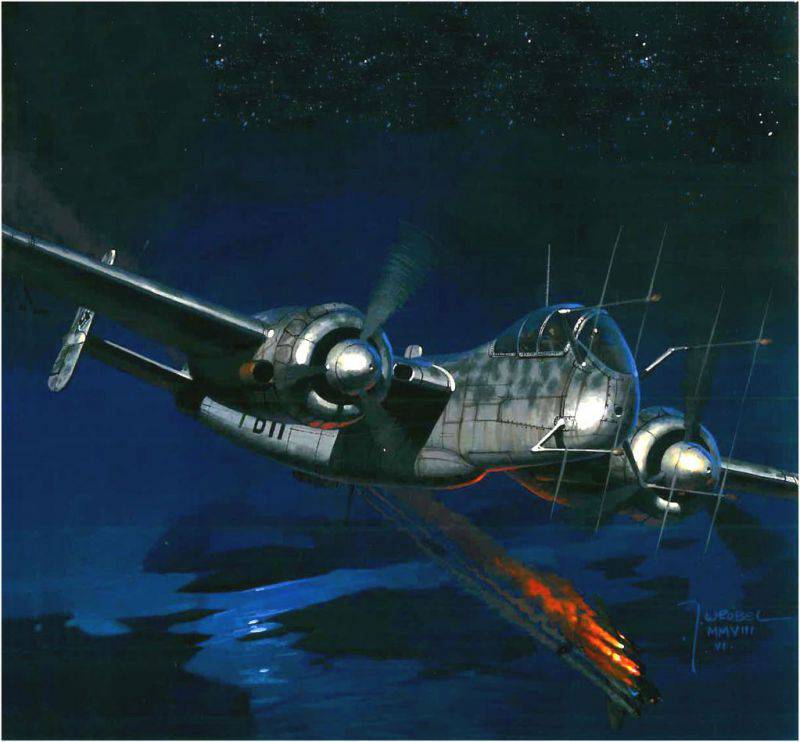
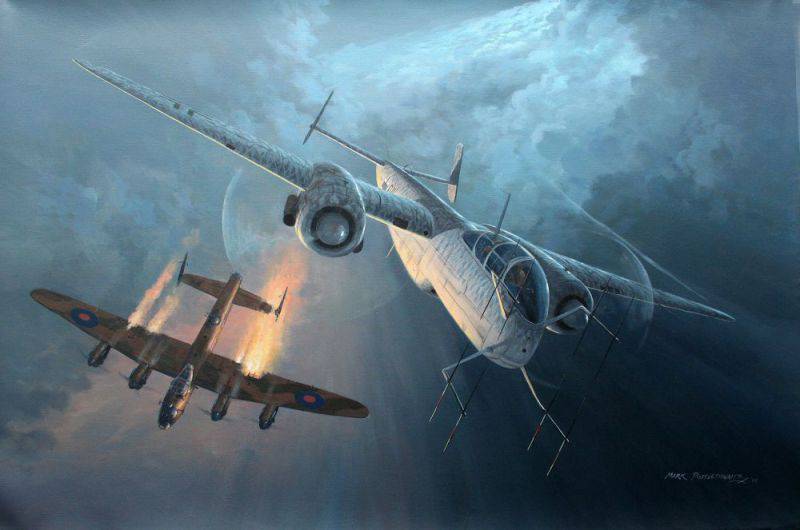
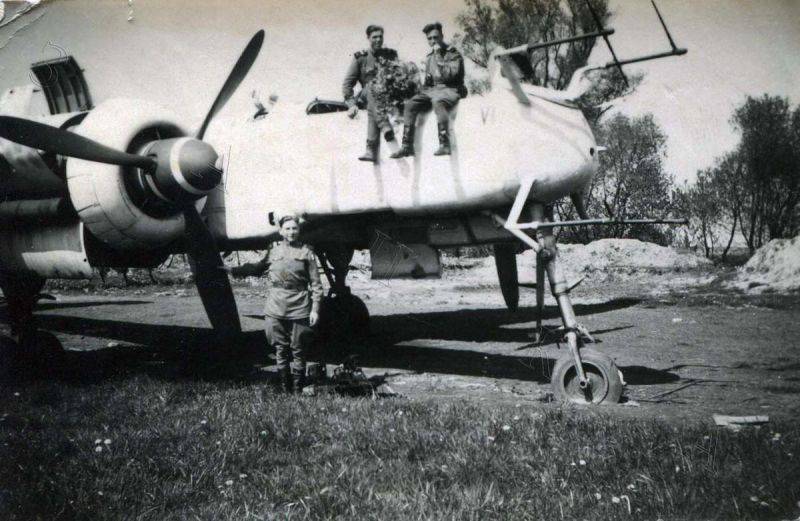
Information